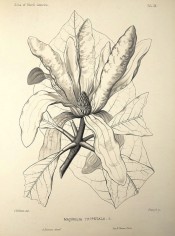Magnolia tripetala L.
Hardy deciduous tree with lance-shaped leaves, to 50cm long, clustered at the end of shoots, and pungently-scented creamy-white flowers in summer, to 25cm across, followed by rosy-red fruits. To 12m. [RHSD, Hortus, Hilliers’].
Horticultural & Botanical History
‘Magnolia tripetala is widely distributed in all the Alleghany-mountain region from southern Pennsylvania to central Alabama, extending in the south Atlantic states nearly to the coast, and west of the mountains to middle Kentucky and Tennessee and northeastern Mississippi, reappearing beyond the Mississippi River in central and southwestern Arkansas.
Magnolia tripetala is nowhere common. It grows naturally only in deep and rather moist rich soil. It occupies the banks of mountain streams, springing from masses of the Great Rhododendron, or is found on the margins of the great swamps which extend along the rivers in the middle districts where it is shaded by forests of the Swamp Chestnut Oak, the Scarlet Maple, and the different Gum-trees, and reaches its greatest size in the valleys which extend from the western slopes of the Great Smoky Mountains in Tennessee.
The wood of Magnolia tripetala is light, soft, close-grained, but not strong. The heartwood is brown and has, when perfectly dry, a specific gravity of 0.4487, a cubic foot of the dry wood weighing 27.96 pounds. The rather heavier sapwood, consisting of thirty-five to forty layers of annual growth, is creamy white.
Magnolia tripetala was first described by Catesby in his Natural History of Carolina, published in 1743, and was introduced into the gardens of Europe as early as 1752. The arrangement of the leaves at the end of the branches, resembling somewhat that of the ribs of an umbrella, led the early settlers in Virginia and Carolina to call this Magnolia the Parasol-tree, or Umbrella-tree; and the specific name, Umbrella, was given to it by Lamarck, who discarded the older Linnaean name referring to the three conspicuous reflexed petaloid sepals. Such a change, in spite of the technical inaccuracy of the name, is contrary to the modern ideas of botanical nomenclature, however, and the Linnaean tripetala is now generally adopted. The hardiness of the Umbrella-tree, its ample foliage, large flowers, and brilliant and conspicuous fruit, have made it a favorite in gardens and parks, in spite of its small size and sprawling habit; and it is one of the most commonly cultivated of the American Magnolias in the northern United States, and in northern and central Europe. It is often used in American nurseries as stock upon which to propagate the less vigorous species. It grows in cultivation with rapidity and vigor, and is hardy as far north as New England.’ [Sargent - Silva of North America vol.1, p.13, pl.9/1891].
Introduced to Britain in 1752. [Hilliers’].
History at Camden Park
Magnolia tripetala is marked with a ‘c’ in an 1836 edition of Loddiges’ catalogue held at Camden Park [CPA]. In William Macarthur’s code, used and explained elsewhere, this means grown at Camden. It is almost certain that it was grown in the gardens around this time but it did not appear in the catalogues and may have been short-lived.
Notes
Published Apr 02, 2010 - 02:57 PM | Last updated Apr 02, 2010 - 03:03 PM
| Family | Magnoliaceae |
|---|---|
| Category | |
| Region of origin | Eastern United States |
| Synonyms |
|
| Common Name | Umbrella tree |
| Name in the Camden Park Record |
Magnolia tripetala |
| Confidence level | high |
